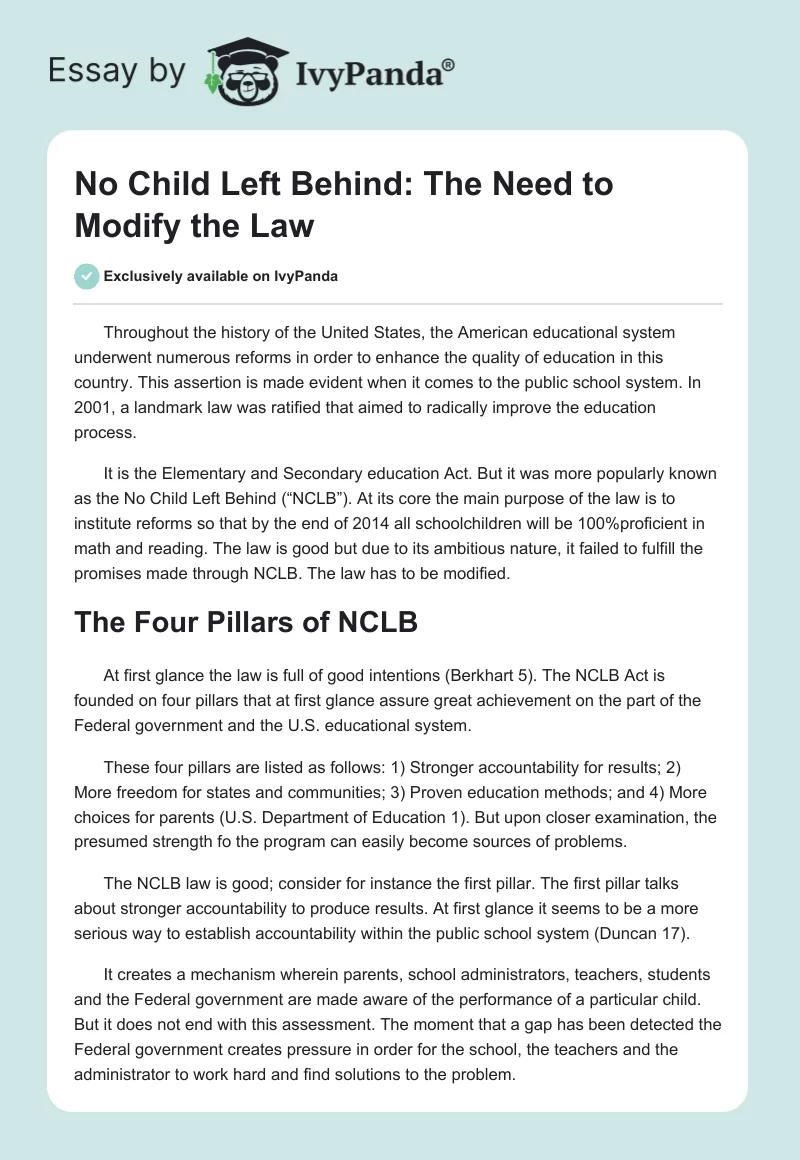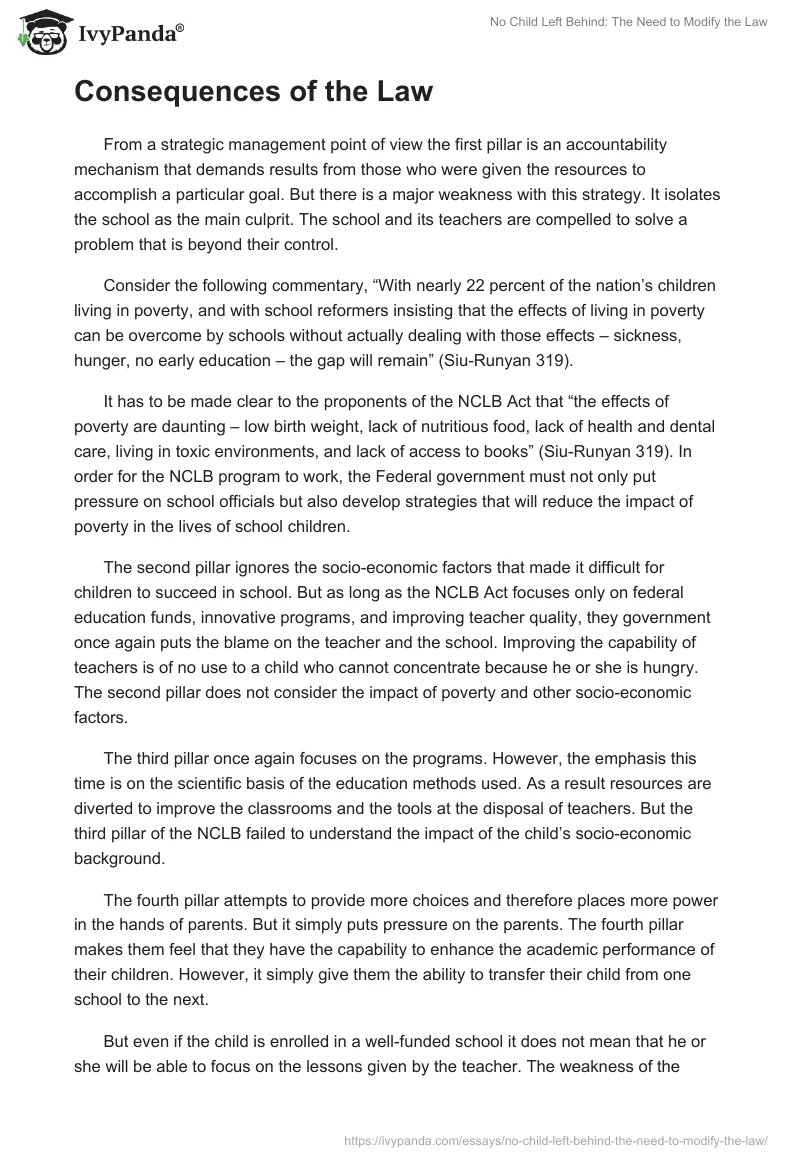Throughout the history of the United States, the American educational system underwent numerous reforms in order to enhance the quality of education in this country. This assertion is made evident when it comes to the public school system. In 2001, a landmark law was ratified that aimed to radically improve the education process.
It is the Elementary and Secondary education Act. But it was more popularly known as the No Child Left Behind (“NCLB”). At its core the main purpose of the law is to institute reforms so that by the end of 2014 all schoolchildren will be 100%proficient in math and reading. The law is good but due to its ambitious nature, it failed to fulfill the promises made through NCLB. The law has to be modified.
The Four Pillars of NCLB
At first glance the law is full of good intentions (Berkhart 5). The NCLB Act is founded on four pillars that at first glance assure great achievement on the part of the Federal government and the U.S. educational system.
These four pillars are listed as follows: 1) Stronger accountability for results; 2) More freedom for states and communities; 3) Proven education methods; and 4) More choices for parents (U.S. Department of Education 1). But upon closer examination, the presumed strength fo the program can easily become sources of problems.
The NCLB law is good; consider for instance the first pillar. The first pillar talks about stronger accountability to produce results. At first glance it seems to be a more serious way to establish accountability within the public school system (Duncan 17).
It creates a mechanism wherein parents, school administrators, teachers, students and the Federal government are made aware of the performance of a particular child. But it does not end with this assessment. The moment that a gap has been detected the Federal government creates pressure in order for the school, the teachers and the administrator to work hard and find solutions to the problem.
Consequences of the Law
From a strategic management point of view the first pillar is an accountability mechanism that demands results from those who were given the resources to accomplish a particular goal. But there is a major weakness with this strategy. It isolates the school as the main culprit. The school and its teachers are compelled to solve a problem that is beyond their control.
Consider the following commentary, “With nearly 22 percent of the nation’s children living in poverty, and with school reformers insisting that the effects of living in poverty can be overcome by schools without actually dealing with those effects – sickness, hunger, no early education – the gap will remain” (Siu-Runyan 319).
It has to be made clear to the proponents of the NCLB Act that “the effects of poverty are daunting – low birth weight, lack of nutritious food, lack of health and dental care, living in toxic environments, and lack of access to books” (Siu-Runyan 319). In order for the NCLB program to work, the Federal government must not only put pressure on school officials but also develop strategies that will reduce the impact of poverty in the lives of school children.
The second pillar ignores the socio-economic factors that made it difficult for children to succeed in school. But as long as the NCLB Act focuses only on federal education funds, innovative programs, and improving teacher quality, they government once again puts the blame on the teacher and the school. Improving the capability of teachers is of no use to a child who cannot concentrate because he or she is hungry. The second pillar does not consider the impact of poverty and other socio-economic factors.
The third pillar once again focuses on the programs. However, the emphasis this time is on the scientific basis of the education methods used. As a result resources are diverted to improve the classrooms and the tools at the disposal of teachers. But the third pillar of the NCLB failed to understand the impact of the child’s socio-economic background.
The fourth pillar attempts to provide more choices and therefore places more power in the hands of parents. But it simply puts pressure on the parents. The fourth pillar makes them feel that they have the capability to enhance the academic performance of their children. However, it simply give them the ability to transfer their child from one school to the next.
But even if the child is enrolled in a well-funded school it does not mean that he or she will be able to focus on the lessons given by the teacher. The weakness of the fourth pillar is exacerbated when it comes to children with disabilities (Lane, Carter, & Sisco 237).
A school may have outstanding facilities and well-trained teachers but none of these are of any help to a child with special needs. In order to narrow the gap, the Federal government must place emphasis on the need to enhance educational programs from the point of view of children with disabilities.
Modification Needed
The first thing that has to be modified is the inclusion of disadvantaged children and children with special needs (Kaufman & Blewett 5). In order to achieve this goal there is a need to revisit the provision in the NCLB Act that requires U.S. states to develop assessments in basic skills (Cho & Kingston, 2011, p.58).
When this aspect of the NCLB law is modified there is no longer pressure to for teachers to improve the performance of children with special needs. When there is less pressure for them, then, they can focus on the need to teach the greater number of students that does not require special attention. It does not mean that kids with special needs must be ignored, but it will require a different set of legislature to deal with their problem. There is no sense to lump together the problem of underachievers with those children with special needs.
Another major modification is to remove the punitive nature of the NCLB law wherein low-performing schools are stripped of resources. Instead of the removal of Federal funds, public schools must be evaluated to figure out the root cause of the problem. If it will be determined that the root cause of the problem is poverty, then, the Federal government comes in to help. As a result the school receives more funds to improve their education system.
A child from a low-income family will not have time and resources needed to learn beyond the four walls of the classroom. Children from low-income families may go to school regularly but it does not mean that they are inspired and willing to learn. It is important to realize that programs and well-trained teachers are not enough to narrow the education gap. This assertion is true especially when it comes to poor children.
The modified NCLB law compels the Federal government to improve the performance of these schools and not threaten them with the warning that funding will be decreased if they are unable to hit their target (Stecher, Vernez & Steinberg 40).
At the same time the primary focus of school officials will be to improve the performance of struggling students (Peterson & Vest 12). There is no need to distract teachers to improve the test scores of children with special needs. Children with special needs will be tested using a different set of standards.
Finally, the full attention of teachers will be focused on teaching students and not worry about the need to overcome the assessment tests given by the Federal government (Sunderman, Kim, & Orfield 10). Therefore, it can be argued that the quality of education was sacrificed for the sake of the approval of the Federal government (U.S. Department of Education 1).
Conclusion
The NCLB Act was created to help students improve their performance. But the law seems to ignore the socio-economic factors that greatly affect the performance of children. Thus, there is a need to modify the NCLB law. There are two major aspects of the law that needs to be modified.
First, the law must remove the provision with regards to disadvantaged children and children with special needs. Second, there is a need to remove the provision in the law that will cut the funding to schools that underperform. The modifications will enable the teachers to focus on teaching students and not on the assessment tests. At the same time it will allow poor children to have access to quality education.
Works Cited
Berkhart, Paul. No Child Left Behind. New York: Nova Science, 2008. Print.
Cho, Hyun-Jeong and Neal Kingston. “Capturing Implicit Policy From NCLB Test Type Assignments of Students with Disabilities.” Exceptional Children 78.1 (2011): 58-72. Print.
Duncan, Arne. “10 years later, time to build on ‘No Child.” The Washington Post. Jan 8, 2012. Web.
Kaufman, Kayne and Evan Blewett. “When Good Enough Is No Longer Good Enough: How the High Stakes Nature of the No Child Left Behind Act Supplanted the Rowley Definition of a Free Appropriate Public Education.” The Journal of Law and Education 41.1 (2012): 5-23. Print.
Lane, Kathleen, Erik Carter, and Lynn Sisco. “Paraprofessional Involvement in Self-Determination Instruction for Students With High-Incidence Disabilities.” Exceptional Children 78.2 (2012): 237-251. Print.
“No Child Left Behind”. Education Week. 2004. Web.
Peterson, Paul and Martin Vest. No Child Left Behind. Washington, D.C.: The Brookings Institution, 2003. Print.
Siu-Runyan, Yvonne. “The 2011 NCTE Presidential Address: Telling Our Stories (Ka Ha’i Mo’olelo ‘Ana).” Research in the Teaching of English. 46(3): 317-329 . Print.
Stecher, Brian, George Vernez and Paul Steinberg. Reauthorizing No Child Left Behind. CA: Rand Corporation, 2010. Print.
Sunderman, Gail, James Kim, and Gary Orfield. NCLB Meets School Realities. CA: Sage Publications, 2005. Print.
U.S Department of Education 2012. Four Pillars of NCLB. Web.


